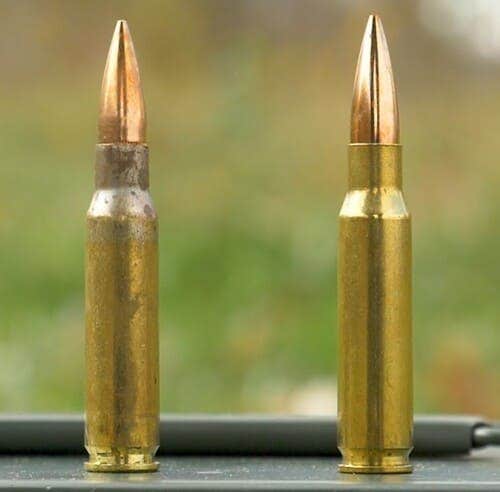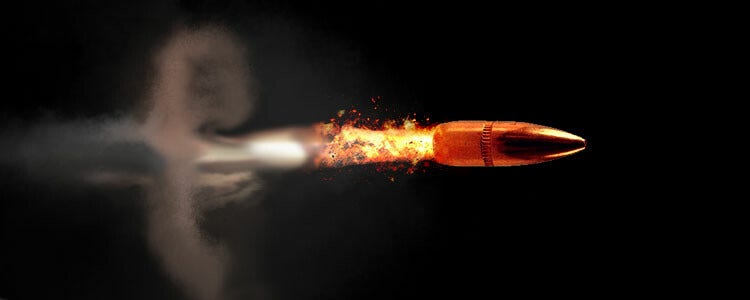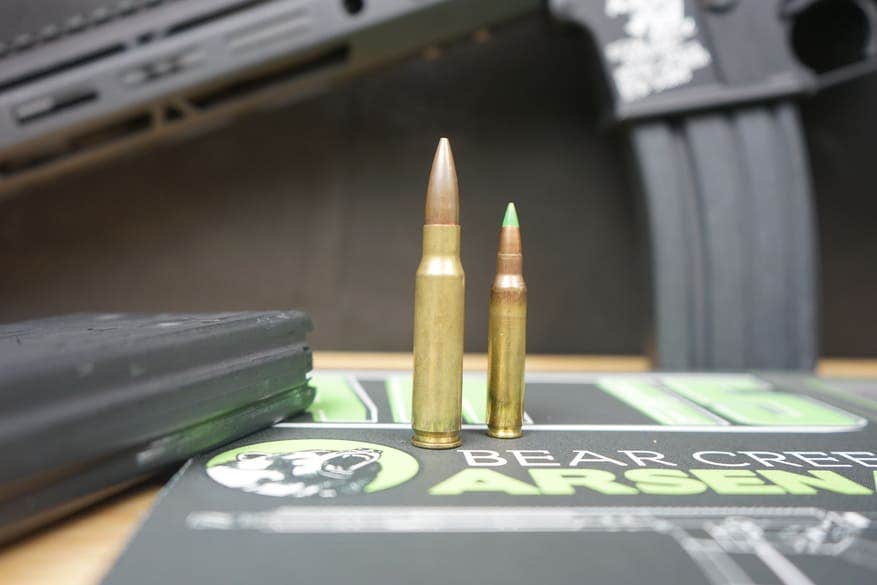History: M4 vs M14s
The most significant performance difference between 5.56 NATO and .308 Win.—or its 7.62 NATO twin—was on full display during ground operations in the global war on terrorism. M4s chambered in 5.56 NATO performed admirably during the close quarters combat common in Iraq, but effectiveness diminished when Afghanistan’s mountains extended engagement distance.
The M4’s shorter barrel is nimble in buildings, but it’s not designed for long-range precision. It also compromises the projectile’s initial velocity, because not all powder may burn completely before it leaves the gun. That can result in increased drop during travel and additional time for wind to push it off course. Bullets delivered from those house-clearing carbines also don’t carry a lot of energy after lengthy travel.
Insurgents, on the other hand, were behind heavier calibers, many of them capable of slicing through breezes and carrying authoritative punch upon arrival. The U.S. military’s Semi-Automatic Sniper System, basically a fully outfitted AR-10 chambered in 7.62 NATO, proved an effective response, but they were not available in sufficient numbers.
The solution had been collecting dust in armories since the Vietnam War. It was a stockpile of M14s whose short stint as the official service rifle ended in 1964 when it was (ironically) replaced by M16. That 7.62 NATO chambering called it back to duty, and M14s retrofitted with optics, rails and bipods in the hands of our troops responded to terrorist attacks at distances far beyond the effective range of M4s.
The 7.62 NATO (twin of the .308 Win.) is the clear winner of the two in the distance race. The 5.56 NATO, however, leads the way in those shorter sprints to the finish line.

7.62×51 NATO vs .308 (Are they the Same?)
Visually these cartridges are identical twins—assuming they’re dressed with the same bullet—but like any siblings, there are subtle differences. The .308 Win. can handle chamber pressure up to 62,000 psi, while 7.62 NATO (or 7.62×51 mm) ammo comes in at 50,000 psi. That means an AR-10 chambered for .308 Win. eagerly and safely digests 7.62 NATO. The reverse, however, is not true. The scarcity of catastrophic failures caused by the improper combination is a clear indication of the uncompromising focus on safety firearm and ammo companies maintain.
Precisely how we arrived at two different names is a story that begins in 1952, when Winchester Ammunition introduced the .308 Win. cartridge. The U.S. military, in the meantime had been experimenting with a replacement for the .30-06 Sprg. cartridge that got us through World War II and Korea. In 1954 the U.S. Army rolled out a 7.62×51 mm cartridge, the identical twin. Some claim Winchester worked with the government on the design but launched early under the company name for marketing reasons. Others, of a more conspiratorial nature, claim someone in the company gained access to the military’s specifications.
Either way, another name was about to enter the picture. The communist menace was growing at the time, and members of the North Atlantic Treaty Organization (NATO) were eager to standardize ammunition between allied nations to alleviate logistics problems. In 1957, a version of the 7.62×51 mm with pressure reduced to reliably run military machineguns and semi-automatics, was accepted and standardized under the label 7.62 NATO.
While AR-10s in .308 Win. can run 7.62 NATO, it’s dangerous for .223 Rem.-chambered AR-15s to run 5.56 NATO cartridges. They are visually similar, but the military version generates higher pressure. An AR-15 chambered for the NATO cartridge, however, can safely run .223 Rem., although some loss in accuracy is possible. [See our article about AR10 Calibers for more information on other calibers for AR10 uppers and AR-10 rifles.]

Ballistics at Distance
Stopping Power
The amount of energy .308 Win. delivers downrange is staggering compared to that of the 5.56 NATO. It’s a huge concern for anyone who hunts big game, and illustrates one of the reasons the U.S. military pulled M14s out of mothballs.
Federal’s American Eagle line—staying with a single manufacturer to avoid the varying barrel lengths different brands sometimes use in testing—demonstrates the difference. Its 55-grain 5.56 NATO load generates 1,223 ft.-lbs. of energy at the muzzle, but the figure drops to a paltry 277 at 500 yards. Conversely, the company’s .308 Win. load with 150-grain bullet launches with 2,648 ft.-lbs. and at 500 yards still delivers 1,089 on target. That’s almost four times the stopping power at five football field lengths.
Wind Drift
Federal’s testing also demonstrates the difference in cartridges when it comes to wind drift. The results are reported for a 10-mph breeze, at full value—perpendicular to the bullet’s direction of flight—and again give the nod to .308 Win. The 5.56 NATO cartridge is off target by 38.1 inches at 500 yards. The .308 Win., however, moves 23.3. That’s more than a foot.
Bullet Drop
The 5.56 NATO load wins when it comes to drop,offering a flatter trajectory than it’s big brother 308 Winchester.With a 200-yard zero, it drops 38.1 inches at 500 yards. The .308 Win. figure is 47.2, or 9.1 inches lower.
Bullet drop, however, is relatively predictable, thanks to the fact that acceleration due to gravity remains 32 feet per second/per second, whether in gale-force winds or 10 mph breezes. Bullet drop compensating reticles harness that fact by providing the correct holdover for that rifle and cartridge at a known distance. You can also dial a rifle’s turret the correct number of clicks to adjust, which is the preferred military solution after lots of practice and copious note taking. For that reason, most precision marksmanship courses recommend, often, “dial for elevation, hold for wind.”
Of course, doping the wind at both the shooting position and target, while gauging crosswinds across 500 yards, is an art that takes years of practice. Reducing potential error by a foot is a huge advantage for .308 Win., along with the added energy delivered on target.
The numbers might make an AR-10 chambered in .308 Win. seem like the clear choice, but there are reasons many enthusiasts find the 5.56 NATO a better one.
Recoil
Recoil is likely the most over-discussed firearm subject that exists. Calculating the precise amount generated when a cartridge is touched off is easy, but how much of it reaches the shooter and is felt—perceived recoil—defies a simple equation.
Bear in mind, both cartridges are tame on the shoulder. The muzzle energy generated by the .308 Win. cartridge above, however, is nearly double that of the 5.56 NATO, resulting in a significant increase in raw recoil. That translates to increased muzzle rise with each shot, lengthening the time it takes to get back on target if a follow-up shot is required.
That fact gives an AR-15 chambered in 5.56 NATO a big advantage if it’s serving as a home-defense gun or pursues speedy predators. That’s one of the reasons the U.S. military has stuck with a cartridge that’s performed so well in Iraq’s urban engagements.
The cycling of a semi-automatic firearm drains some of that recoil compared to a bolt gun, however, long before it ever reaches the shooter. So does every ounce of the gun’s weight, along with accessories and scope. Add a recoil pad and perhaps even a muzzle brake and that .308 Win. recoil is almost as pleasant to shoot at a 5.56 NATO, but it won’t be nearly as nimble in that configuration. [See our complete comparison of AR10 vs AR15 rifles.]
Hunting & Bullet Choices
In many areas of the country pursuit of big game is not legal with a 5.56 NATO-chambered rifle. It is, however, allowed nearly everywhere with a .308 Win.
The smaller cartridge just doesn’t retain the kind of energy downrange for most hunters to deliver ethical one-shot stops. Even in practiced hands, the selection of bullets available today is limited, and most often available in match, full metal jacket or predator-hunting designs. There are some controlled expansion bullets available, but .308 Win. gets the nod here, thanks to an inventory of projectile choices that overwhelms those available for 5.56.

Ammo
Bargain-basement prices for 5.56 NATO and .223 Rem. may not have survived the pandemic’s ammunition shortage, but they’re still inexpensive compared to other centerfire rifle cartridges. It’s hard to find a sporting goods store or FFL that doesn’t have a few boxes on the shelf, cases in back or pallet staged by the cash register. If high-volume practices are on the schedule, it’s the best choice.
That’s not the case with .308 Win. or 7.62 NATO. These cartridges are more expensive, although it’s hard to beat the performance downrange, along with the its long history of winning matches and bagging big game.
[308 ammunition can often be up to twice as expensive as 5.56 or 223 ammo, but offers a huge variety of grain weights for hunting and long range shooting. See our infographic comparing 2022 ammo prices by caliber.]
Which is Better?
[As Eric Shattuck said in his article about AR-10s vs AR-15s, “Ultimately, the choice between an AR-10 (.308) and an AR-15 (5.56/223) comes down to what you need out of your rifle.” We couldn’t agree more! If you’re looking for a rifle to do competitive target shooting, long range shooting, or medium to large game hunting, then 308Winchester is the way to go. However, if you simply want a low cost, versatile self-defense or plinking gun, 5.56 NATO/223 Remington will be the better option.
We would like to extend a huge thank you to Guy Saji for his work on this article comparing 308 Winchester and 5.56 NATO/223 Remington. Leave a comment below about your favorite AR-platform caliber and read about 6.5 Creedmoor vs 308 next!]











































